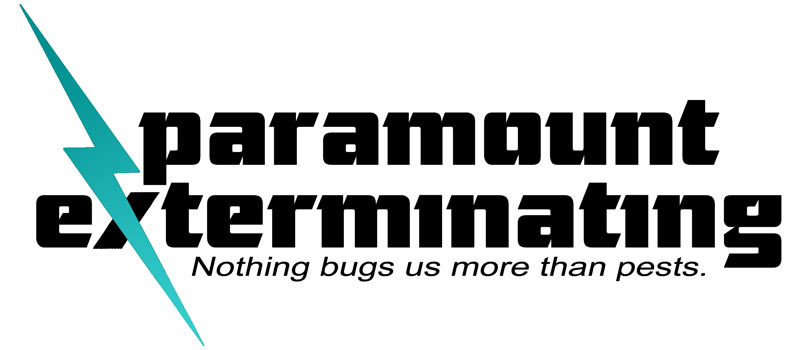CALL US TODAY! 800-273-6050
WHAT TYPE OF BEE OR WASP IS IT?
- Yellow Jacket Wasp
- Bald Faced Hornet
- Mud Dauber Wasp
- Honey Bee
- Carpenter Bee
- Cicada Killer Wasp
- Bumble Bee
- Paper Wasp
 Name: Yellow Jacket Waspt (Vespula)
Name: Yellow Jacket Waspt (Vespula)
Appearance: Yellow jackets get their common name from the bold yellow and black markings on their bodies, and also occasionally appear with black and white coloring. Unlike bees, yellow jackets have thin, narrow waists and elongated wings. ½” to 1” in length.
Habit: While most yellow jackets are known to be ground-nesters, they can and will form nests in a variety of places, including both below and above ground nesting sites. They are often seen nesting in sidewalk cracks, in and around outdoor structures, underneath roof eaves, and underneath wooden porches.
Health/Damage Concerns: Yellow jackets are known to be aggressive when disturbed, especially when near the colony site. They are able to inflict painful stings that can cause serious allergic reactions in some people, making them a danger when a nesting site is near a populated area.
Diet: Yellow jackets are beneficial insects. The larvae feed on other insects, insect larvae, and other proteins that are captured by the adults. The larvae convert this protein into “honeydew”, a sweet, sugary substance, which is feed on by the adults. When people see yellow jackets hovering around the grill during the early spring/summer time, they are actually seeing the adults forage for food for the larvae. The adults themselves eat sweet, sugary substances and are well feed most of the early summer by the larvae’s honeydew. It is only later in the summer when the larvae no longer produce their honeydew, that the adults begin to scavenge for any sugary substance they can find like soda, beer, and other sweets.
Reproduction: Colonies of yellow jackets can become quite large, especially in instances of mild winters. The colony consists of workers that are sterile adult females and a queen. Males will appear in late summer to mate with the fertile females that will eventually become queens. The females will then hibernate until next summer. Males and workers will eventually disappear as the temperature begins to drop.
Name: Dolichovespula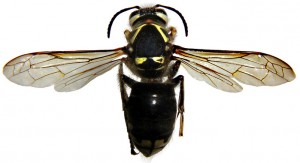
Appearance: The bald-faced hornet is closely related to the yellow jacket wasp. ¾” to 1- 1/4” in length. Distinguishable by the white markings on its body and face.
Habit: Bald-faced hornet nests are often found hanging in bushes, trees, buildings corners, and underneath roof eaves. They are aggressive and can cause very painful stings and serious allergic reactions, please call your local pest professional when dealing with stinging insects.
Health/Damage Concerns: Hornet nests can become very large, very quickly. In fact, nests can become the size of a basketball in as little as a few months. Despite hornets being beneficial pests, they should not be allowed to create nests near populated areas. Hornets can be very aggressive, especially when disturbed, and cause painful and dangerous stings. Hornet stings can cause serious, sometimes fatal allergic reactions! Please call your local pest professional when dealing with stinging insects.
Diet: Sugary liquids; plant nectar.
Reproduction: In spring, a queen bald-faced hornet will begin to form a nest, laying one egg in each cell. Those cells are stocked with insects and nectar for the newly emerged larvae to feed on. These larvae will eventually become workers in the colony. Male bald-faced hornets arrive in late summer to mate and produce new queens for the following year. As the temperature drops, new queens search out places to hibernate for the winter, while the workers will perish due to the cold.
 Name: Mud Dauber Wasp (Sceliphron caementarium)
Name: Mud Dauber Wasp (Sceliphron caementarium)
Appearance: Long and slender in shape, coloring varies from black and yellow, metallic blue, to completely black. Most species have a very long, thin waist. ¾” to 1” in length.
Habit: Mud daubers are known to continually occupy a particular area year after year if left undisturbed. This may result in nesting sites accumulating over time, and a large population of the pests in that area. They create mud nests that are often hidden in areas that are protected from the elements. The size and shape of nest created varies with the particular species of mud dauber; most creating nests that are small in size with several exit holes that will remained sealed until the offspring are ready to leave the nest.
Health/Damage Concerns: Mud daubers are generally not aggressive unless disturbed or handled. When dealing with stinging pests, it is always best to contact your local pest control professional.
Diet: The adult mud daubers diet is similar to most wasps, feeding on flower nectar and other sweet foods. However, they are also predators, capturing spiders to provide food for their offspring. The female wasp will collect up to a dozen spiders to provision her nesting site. The larvae will feed on the spiders until they are ready to emerge from the nest.
 *Honey bees are a protected species and should NOT be destroyed if at all possible. This may mean removing the nest and the bees themselves, and this should ALWAYS be done by a trained professional.
*Honey bees are a protected species and should NOT be destroyed if at all possible. This may mean removing the nest and the bees themselves, and this should ALWAYS be done by a trained professional.
Name: Apinae
Appearance: About 15 millimeters in length and light brown/yellow in color. Their bodies are covered in a fine coating of hair.
Habit: Honey bees, like many bees species, are social creatures that live in large colonies. Each caste of bee has a specific duty; some will build and repair the nest, others will forage for food, and others will protect the larvae. Honey bees are often most visible during the late spring and summer months when queens begin looking for potential nesting sites. It is during these months that they are often seen swarming in large groups around the queen during her search.
Health/Damage Concerns: Most bees are harmless unless disturbed, but some species are aggressive and will attack unprovoked. Bee stings can cause serious, sometimes fatal allergic reactions! Please call your local pest professional when dealing with stinging insects.
Diet: Pollinators; adults also feed on plant nectar and their own honey.
Reproduction: The queen will lay eggs in the protected cells inside of the nest. When the eggs hatch, the larvae feed on pollen and honey for several weeks before they are ready to emerge from the nest. There is only one queen per colony, and she is responsible for creating thousands of offspring every year.
 Name: Carpenter Bee
Name: Carpenter Bee
Appearance: Similar in appearance to bumblebees, the carpenter bee is distinguishable by its shiny black, hairless abdomen. They are often seen hovering around roof eaves and drilling into wooden porches outside homes.
Habit: Male Carpenter Bees are unable to sting, and females rarely do unless provoked or handled. Despite their name, Carpenter bees do not actually feed on wood. The tunnels that they make are used as shelter and as a harborage for their young. They commonly make ½ inch diameter holes in unpainted wood objects like windowsills, doors, roof eaves, porches and wood railings, shingles, and wood furniture. Over time, nesting sites can cause considerable structural damage that may result in costly repairs. They will often leave droppings on walls or other areas near their nesting site which can cause staining.
Diet: Pollenating bee species.
Reproduction: Carpenter bees will hibernate during the winter, emerging in the spring to mate and create new nesting sites. New hatchlings generally emerge in early August.
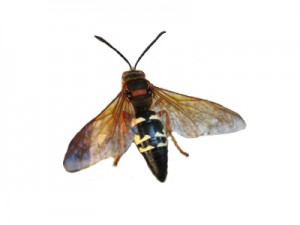 Name: Cicada Killer Wasp (Sphecius speciosus)
Name: Cicada Killer Wasp (Sphecius speciosus)
Appearance: Cicada killer wasps are one of the largest wasps in North America, growing between ½” to 2” inches depending on the sex (females grow to roughly twice the size of males). Their bodies are covered in yellow and black stripes, with reddish-brown wings.
Habit: These pests are often first seen in the late summer months, and are gone again by the early fall. Cicada killer wasps are burrowing pests, creating holes and subsequent “mounds” in lawns and gardens. These holes are dug by the female wasp to create a nesting site for her young, and are generally around 10 to 20 inches deep and a ½ inch wide. They are often seen burrowing in all types of lawns, flower beds, and gardens, and prefer areas that are in direct sunlight.
Health/Damage Concerns: Cicada killers are often feared because of their large size and hornet-like coloring, but are typically non-aggressive. Females have been known to sting on occasion, but not unless they are aggressively handled.
Diet: Adult Cicada killer wasps are plant feeders that enjoy plant nectar and sap. The adults do NOT feed on Cicadas. Females will paralyze cicadas with their sting in order to bring them back to their nesting site to feed to their offspring.
Reproduction: During the summer months, male and female Cicada killer wasps begin mating. Females will find an area to burrow a suitable nest, and then begin the search for cicadas with which to provision her nest. Females will capture a certain number of cicadas depending on the sex of the offspring; 1 cicada for male offspring, and 2 to 3 for females, as they will grow to nearly twice the size of the male. The newly hatched grubs will use the cicadas as food, and will emerge from the nesting site several weeks later. Burrows often have more than one nest cell, with other females using the same main tunnel as other females, but burrowing off of the main tunnel and creating their own nesting cell.
Name: Bumble Bee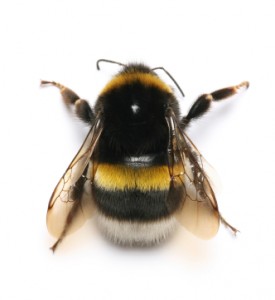
Appearance: Bumble bees are often identified by the long, yellow and black striped hair that covers their bodies. Some species may vary in coloring from solid black to orange or red markings. They have a fuzzy, soft appearance.
Habit: Like many bee species, bumble bees are social and form colonies. These colonies are often smaller than honey bee colonies, often housing less than 50 bees. This is due to the relatively small nest size, and the fact that only one female is in charge of building and fertilizing the nest. Colonies only last a single season as a result.
Health/Damage Concerns: Bumble bee stingers lack the barbs that honey bees have, giving them the ability to sting more than once. However, they are not normally aggressive unless they are handled or their nest becomes threatened. Like most bee species, bumble bees are beneficial to the environment as they are pollinators of flowers and crops, and should be left alone if possible.
Diet: Pollinators; Adults feed on plant nectar, and collect pollen to feed their young.
Reproduction: Fertilized queens are responsible for the creation a new colony every season, as the rest of the colony will die off over the winter months. The queen has the ability to choose the sex of her offspring before laying her eggs by choosing to whether to fertilize them. Non-fertilized eggs become males, while fertilized eggs will become females or potential new queens. Slight hormonal differences between the queen and new females prevent the new females from developing functional ovaries, allowing the queen to maintain control of the colony.
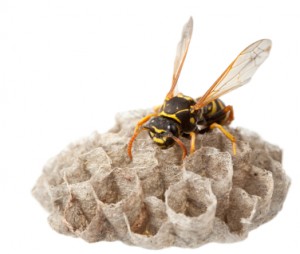 Name: Paper Wasp
Name: Paper Wasp
Appearance: ¾” to 1” in length. They are similar in appearance to the yellow jacket wasp, with black and yellow (sometimes white) markings and a very narrow waist. However, paper wasps are larger and have a larger wingspan.
Habit: Paper wasps get their name from the way the form their nests. By using a mixture of their saliva and fibers from plants and wood to create a greyish-brown, paper-like substance, they can create open-combed nests. These open-combed nests are a distinguishing characteristic of the species. To protect the nest, the adult wasp will secrete an ant repellant chemical that prevents ants from stealing eggs or damaging the nest. These nests often appear in the spring and summer months under roof eaves, decks, and occasionally patio furniture.
Health/Damage Concerns: Wasps are known to be aggressive when disturbed, especially when near the colony site. They are able to inflict painful stings that can cause serious allergic reactions in some people, making them a danger when a nesting site is near a populated area.
Diet: Plant nectar/other insects; Paper wasps are considered beneficial pests because they will eat plant destroying insects like beetle larvae and caterpillars.
Reproduction: Paper wasps are social insects, with mature nests housing around 20 adult wasps. Their colony is based on a three cast system of queens, workers, and males. Workers are sterile females that are in charge of building and protecting the nest, and feeding the young. Each egg is laid into a single cell, which will remain open throughout the entire pupation process. Queens stop laying new eggs in the late summer, and begin their search for a protected area where they can over-winter. This is often in cracks and crevices around structures or behind loose pieces of tree bark. The remaining colony will not survive the winter.
BEE & WASP FACTS
Pest Entry: Bees and wasps tend to be an outdoor nuisance in the spring and summer months. Some of these pests form nests in trees and under roof awnings, while some others burrow nests into the ground. The yellow jacket is notorious for ruining out door events during the late summer with their strong liking for sweet and sugary foods during those months.
Environment: Most of these pests are only seen active over the spring and summer months. This is because male reproductives often die off after mating, with the females seeking safe places to overwinter. They thrive in moderate to warm temperatures and can sometimes survive into the early fall if the conditions are right.
Reproduction: These pests generally mate during the summer months, with females overwintering and laying eggs the following spring.
Health/Damage Concerns: Some of these pests can cause damage to lawns and wood furniture, others can cause painful stings and just plain intimidation. It is best to let a professional handle these pests as they may become very aggressive if disturbed. Honey bees are now a protected species and should NOT be destroyed if at all possible. This may mean removing the nest and the bees themselves, and this should ALWAYS be done by a trained professional.
Home Remedies: Nest removal can be a difficult process, and in some cases not recommended. Many of these species are highly beneficial to our ecosystem and their removal may eventually result in upsetting that delicate balance. Even yellow jackets, despite their stigma, are very beneficial. For most of the spring and summer they feed on other insects and are non-aggressive. It is not until late summer that they start to search for sweet foods and become aggressive in their pursuit.
Why Families and Businesses Choose Paramount
- Faster Service – Get your services scheduled quickly and on YOUR time. No one wants to wait weeks for treatment, and we get that.
- Local and Reliable – We have pest control technicians in Union City, Jersey City, Hoboken, Weehawken, North Bergen, and Hudson County everyday to assist our customers at a moments notice!
- More Efficient – We get things done right the first time, saving you time, money, and frustration.
- Better Tools – Our technicians only use the best products available on the professional market making treatments more effective and longer lasting.
- Better variety of treatment methods – Including green treatments and baiting programs.
- More Experience – We’ve been defeating all types of pests since 1930, and have the most experienced technicians in the industry.
HOURS OF OPERATION
Monday – Friday: 8am – 4pm
Saturday: 8am – 2pm
Sunday: Closed
• 24-Hour Emergency Service Available •
• Free Evaluations •
Proudly Serving Jersey City, West New York, Guttenberg,
Hoboken, Weehawken, Secaucus, & All of Hudson County
CALL US TODAY
Union City, NJ Rutherford, NJ Ridgewood, NJ
(201) 865-7799 (201) 945-7066 (973) 423-0234
Newark, NJ NJ Toll Free Jersey City, NJ
(973) 242-2212 (800) 273-6050 (201) 435-5900
